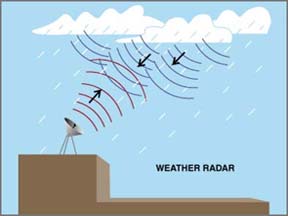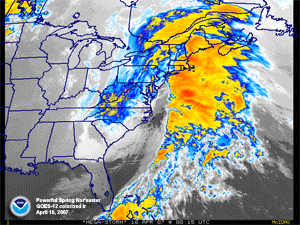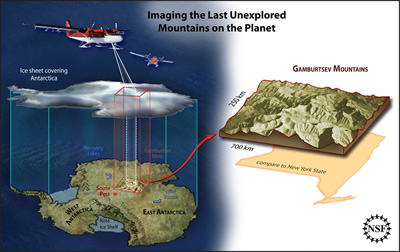This radar was used in a field project run by the National Center for Atmospheric Research in Taiwan.
Click on image for full size
Image courtesy of the University Corporation for Atmospheric Research
How Radar Works
Radar is short for "radio detection and ranging". A transmitter emits pulses of high frequency electromagnetic waves (radio waves). These waves strike conductive objects and are backscattered to the receiver. A radar echo shows up on a monitor and shows where the object is located.. A computer measures the time it takes for the signal to reflect off the target and then calculates how far away it is.
Radar is used extensively in the military as both an offensive and defensive weapon. Aggressors can use radar to locate areas where they want to attack. Defenders can use radar as an early warning of an impending attack. New stealth technology has begun to make current radar systems useless because of the way objects are designed to not reflect radar waves. One drawback to using radar in a battle situation is that detection is a two way street. If you use radar to try and find an enemy, that enemy will know where you are. This is just like using a flashlight in the dark.
There are many scientific uses of radar, but the most well-known by the public is weather radar. Weather radar is an important forecasting tool, especially for very short-term forecasts. Radar is also used to study other aspects of the atmosphere, such as mapping wind patterns. For example, if scientists know how the wind is blowing in the upper atmosphere, they can predict what areas could be affected by air pollution. Planetary probes such as Magellan also use radar for surface mapping missions.
You might also be interested in:

Radar is important to weather forecasters because it can detect rain and hail in clouds. The radar emits radio waves in all directions. When a radio wave hits water or ice particles, some of the energy
...more
Wind is moving air. Warm air rises, and cool air comes in to take its place. This movement creates different pressures in the atmosphere which creates the winds around the globe. Since the Earth spins,
...more
What do smog, acid rain, carbon monoxide, fossil fuel exhausts, and tropospheric ozone have in common? They are all examples of air pollution. Air pollution is not new. As far back as the 13 th century,
...more
Most tornadoes form in a part of a supercell thunderstorm called a mesocyclone. The mesocyclone draws energy into the storm so it can last for hours. Scientists aren't sure why, but some can create tornadoes.
...more
This radar image shows a northeaster that moved through the east coast of the United States on April 15-17, 2007. Several areas in the Mid-Atlantic and northeast regions were flooded because of heavy rain
...more
If Uranus is the "tilted planet", Mercury might be called the "upright planet". The spin axis of Uranus, which defines the locations of the planet's North and South Poles, is tilted by 98°. The spin axis
...more
Flying twin-engine light aircraft the equivalent of several trips around the globe and establishing a network of seismic instruments across an area the size of Texas, a U.S.-led, international team of
...more















